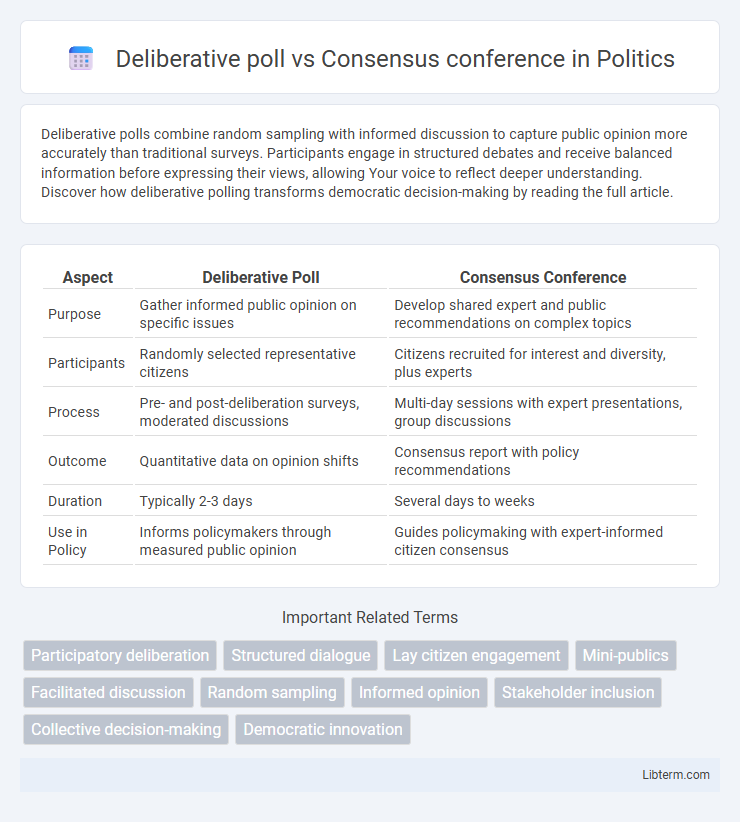Deliberative polls combine random sampling with informed discussion to capture public opinion more accurately than traditional surveys. Participants engage in structured debates and receive balanced information before expressing their views, allowing Your voice to reflect deeper understanding. Discover how deliberative polling transforms democratic decision-making by reading the full article.
Table of Comparison
| Aspect | Deliberative Poll | Consensus Conference |
|---|---|---|
| Purpose | Gather informed public opinion on specific issues | Develop shared expert and public recommendations on complex topics |
| Participants | Randomly selected representative citizens | Citizens recruited for interest and diversity, plus experts |
| Process | Pre- and post-deliberation surveys, moderated discussions | Multi-day sessions with expert presentations, group discussions |
| Outcome | Quantitative data on opinion shifts | Consensus report with policy recommendations |
| Duration | Typically 2-3 days | Several days to weeks |
| Use in Policy | Informs policymakers through measured public opinion | Guides policymaking with expert-informed citizen consensus |
Introduction to Deliberative Polls and Consensus Conferences
Deliberative polls actively engage a representative sample of citizens who receive balanced information and participate in structured discussions to form informed opinions on policy issues. Consensus conferences bring together a small, diverse group of laypeople who collaborate with experts to reach collective agreements on complex scientific or technological topics. Both methods enhance democratic participation by promoting informed, reflective decision-making through deliberation among ordinary citizens.
Origins and Historical Context
Deliberative polls originated in the 1980s through James Fishkin as a method to gauge informed public opinion by combining random sampling with structured deliberation. Consensus conferences began in Denmark during the 1980s, initiated by the Danish Board of Technology to involve lay citizens in evaluating new technologies. Both methods emerged from a desire to enhance democratic participation and improve the quality of public decision-making amid increasing technological and social complexities.
Methodological Frameworks Compared
Deliberative polls employ a random, representative sample of participants who receive balanced information and engage in facilitated discussions to gauge informed public opinion on complex policy issues. Consensus conferences bring together a smaller, diverse group of lay citizens who interact closely with experts to collaboratively develop consensus-based recommendations. Both methodologies prioritize informed deliberation but differ in scale, participant selection, and the extent of expert involvement within their methodological frameworks.
Participant Selection and Recruitment
Deliberative polls recruit a statistically representative sample of the population through random selection techniques, ensuring demographic diversity to reflect public opinion accurately. Consensus conferences select participants through a combination of random draws and purposive sampling, focusing on lay citizens typically unfamiliar with the topic to encourage unbiased, balanced discussion. Both methods emphasize inclusivity but differ in balancing representativeness and deep engagement to facilitate informed deliberation.
Process and Structure of Engagement
Deliberative polls engage a random, representative sample of the population in structured information sessions followed by moderated discussions to measure informed public opinion on specific issues. Consensus conferences bring together selected lay participants and experts through facilitated workshops aimed at joint learning and consensus building on complex, often technical topics. The Deliberative poll emphasizes statistical representation and opinion shifts, while the Consensus conference prioritizes collective agreement and shared understanding among participants.
Role of Experts and Facilitators
In deliberative polls, experts provide balanced information and answer participant questions to ensure informed decision-making, while facilitators guide discussion and maintain neutrality without influencing opinions. Consensus conferences rely more heavily on expert testimony to present diverse viewpoints, with facilitators actively managing dialogue to build agreement among participants. Both methods emphasize expert input and skilled facilitation but differ in expert roles: deliberative polls prioritize neutral information delivery, whereas consensus conferences focus on expert-driven dialogue to achieve consensus.
Outcomes and Decision-Making Approaches
Deliberative polls generate outcomes by aggregating informed public opinions through statistically representative sampling, providing policymakers with quantifiable data that reflect shifts in participant views after deliberation. Consensus conferences emphasize collaborative decision-making, where a diverse group of stakeholders seeks to reach collective agreement on complex issues by engaging in facilitated dialogue and expert testimony. While deliberative polls prioritize measuring opinion change to guide policy, consensus conferences focus on producing jointly endorsed recommendations that embody shared understanding and compromise.
Strengths and Limitations of Each Method
Deliberative polls excel in providing statistically representative insights by combining random sampling with informed deliberation, ensuring results reflect broader public opinion; however, they require significant time and resources for recruitment and facilitation. Consensus conferences foster deep engagement among diverse stakeholders, promoting mutual understanding and collaborative problem-solving, yet they may struggle with representativeness and can be influenced by dominant voices within the group. Both methods enhance democratic decision-making by emphasizing informed dialogue but differ in scale, inclusivity, and logistical demands.
Applications in Policy and Public Discourse
Deliberative polls are widely applied in policy-making to gauge informed public opinion by engaging a representative sample in structured discussions, directly influencing legislative decisions and electoral reform. Consensus conferences bring together diverse stakeholders, including lay citizens and experts, to collaboratively address complex policy issues such as environmental regulation and health care, fostering inclusive and transparent public discourse. Both methods enhance democratic legitimacy by integrating well-informed citizen input into political agendas and facilitating more nuanced, evidence-based policy deliberations.
Choosing Between Deliberative Polls and Consensus Conferences
Deliberative polls provide statistically representative insights by sampling a broad population, allowing policymakers to gauge public opinion shifts after informed discussion. Consensus conferences gather a smaller, diverse group of citizens to collaboratively explore complex issues, emphasizing in-depth dialogue and consensus-building among participants. Choosing between deliberative polls and consensus conferences depends on goals: seek broad public opinion reflection or prioritize thorough, qualitative consensus on specific topics.
Deliberative poll Infographic

 libterm.com
libterm.com